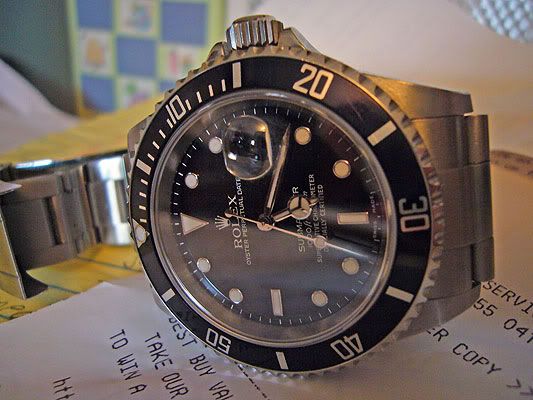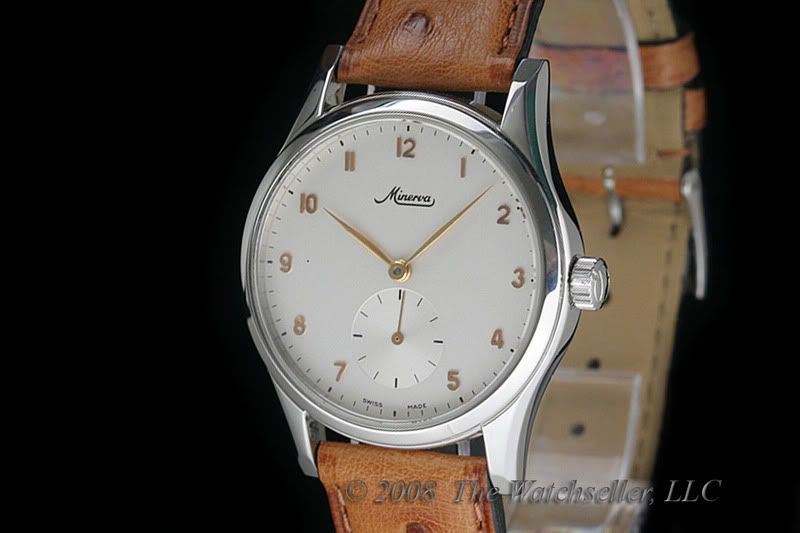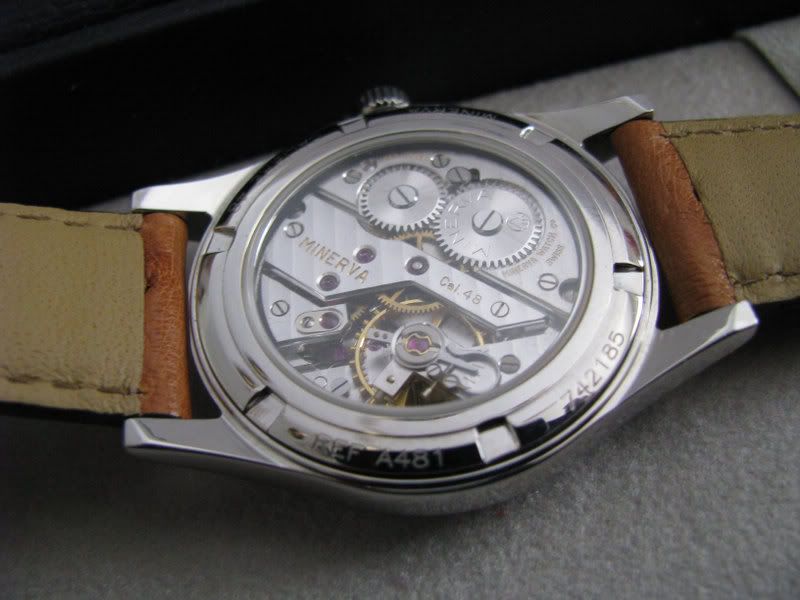A Beginner's Guide to Nice Wristwatches
Some of my friends and coworkers are aware that I love watches, but none of them is particularly savvy about watches or their appeal for me. As my fellow watch aficionados present their State of the Collection posts at TimeZone, I would like to do the same here, only with my humble collection and a little history.
I was in the sixth grade when I received my first Timex wristwatch, and I have worn a watch of some kind ever since. It is a standing joke that certain old boyfriends and my husband have never seen the skin beneath my watch. Perhaps knowing the time is a way of compensating for getting lost so often. Unfortunately, loving watches does NOT seem to make me consistently prompt.
At any rate, I had a seemingly endless parade of Seikos through my school years. After my parents died ten years ago and I was more financially flush than usual, I decided that my next watch should be one in which I could take pride and one that I would keep for a long time. When the salesperson showed me a number of watches, I found myself thinking, "These are great, but will I regret it if I don't get a Rolex?" For I, like many people, knew that Rolex made good watches that were also status symbols. I bought a Lady DateJust (left), which has served me well.
 It was practical, water-resistant, dependable, pretty, and it said Rolex on the dial. Simply because it was expensive, I believed that it was appropriate to wear it to relatively formal occasions, if watches were being worn at all (I have since learned otherwise.) I figured that the Lady DateJust was the only watch I would ever buy.
It was practical, water-resistant, dependable, pretty, and it said Rolex on the dial. Simply because it was expensive, I believed that it was appropriate to wear it to relatively formal occasions, if watches were being worn at all (I have since learned otherwise.) I figured that the Lady DateJust was the only watch I would ever buy.
Several years later, however, I found myself thinking about my late father's watch. From my earliest childhood, Dad had worn a Rolex Oyster from the 1940s or 1950s. My mother had given it to him following WWII. No one in the family ever mentioned that it was a Rolex, and--particularly since Dad kept it on a Speidel Twist-o-Flex watchband--it received little if any notice. During one period (the late 1960s or early 1970s?) Dad further adulterated it with the addition of little aluminum calendars that were bent around the band so he could read them if he twisted his hand toward his body. Later in his life my father tired of the expense and effort involved in having his Oyster cleaned and adjusted at regular intervals. He traded it in on a disposable Bulova watch that has since disappeared. Had he ever mentioned his Rolex to me, I would have jumped at the chance to take it.
Instead, years later, I poured over vintage watch sites, seeking its double. I bought a used Oyster that looks a lot like my father's watch (right), although my memory is too vague for me to be certain. Although the Presidential bracelet (substituted for an Oyster bracelet by the dealer "since women tend to prefer the Presidental bracelet") is too large to look feminine, and the watch itself dwarfs my DateJust, I appreciate the increased dial size and its simple classic appearance.
It was three years ago that I started visiting the TimeZone site. I learned there that Rolex is not the be-all and end-all of watches. Other makers such as Patek Philippe, A. Lange & Sohne, and Vacheron Constantin are held in much higher esteem. Although many of us have heard self-deprecatory jokes from Rolex owners about how their watches are often wrong, they are not really laughing at themselves so forcefully, as it is not accuracy that is most highly prized by serious watch fanciers. If you really want an accurate watch, get a quartz watch or a watch that resets itself frequently via satellite. Most such watches require batteries, but are relatively robust. The appeal of a mechanical watch lies in its old-fashioned craftsmanship. No one really believes the old advertising slogan that a Rolex takes a year to manufacture--and indeed Rolex does make some quartz watches--but a Swiss mechanical watch has behind it an aura forged by hundreds of years of painstaking development. The advent of quartz watches during the 1980s nearly destroyed the Swiss watchmaking industry; those of us who still cherish the old way appreciate mastery of the horological art--not just timing precision.
One aspect of such mastery is the phenomenon of a manufacture. A manufacture is a watchmaking company that makes all its own parts in-house. This is not nearly as common as you might expect. Most watch companies buy an ébauche or stock movement, and then make certain adjustments to it as part of the manufacturing process. ETA is the name of the primary ébauche manufacturer in Switzerland and Miyota is the name of the largest ébauche manufacturer in Japan. Dials and cases may come from separate companies as well. All things being equal, a serious watch aficionado is likely to have special respect for a manufacture.
You might think that women's watches, often laden with jewels and typically more miniaturized, would be among the most highly valued watches. Alas, this is not so. The finest watchmakers typically invest relatively little effort in courting female watch buyers--at least if we measure their interest by counting the number of models of watches that they make for men and for women. A woman who is interested in innovative watchmaking is likely to find herself looking at men's watches. Since I started buying higher-end watches, I have yet to buy another woman's watch.
Pocket watches found their way onto the human wrist during WWI, and at that time, wrist watches were born. Wrist watches of the 1920s, 1930s and 1940s were much smaller than those of today, with the exception of pilot watches. Vintage watches of the early twentieth century appear small to the modern eye and are an excellent fit for modern women.
Here is an inexpensive Croton watch made in the 1940s. One of the things I liked best about it, besides its salmon-colored dial and rose-gold-plated case, is its original clamshell presentation box. The Croton's dial is only as wide across as a nickel. In real life the printing on the dial looks black.
If miniaturization, bling, and accuracy are not the primary criteria by which high horology is judged, what are? Part of the picture is creativity and design, both inside and outside of the watch case. Direct drive technology and other new developments excite those who know more about the inner workings of a watch than I do. I, on the other hand, can at least appreciate complications.
Complications are what we call those parts of a watch that do more than tell the hour and minute and seconds. One of the most common complications is a chronograph; that is, a set of extra subdials that show the time that has elapsed since the pressing of a pusher. (A chronograph is different from a chronometer. My father's chronometer, shown above, obviously has no extra subdials. The term chronometer refers to watch that has passed a special accuracy test performed in Switzerland.) Some chronographs can time events that take hours to complete. Others can time two events simultaneously while still mainting the basic timekeeping function. Moon phase watches feature tiny graphics that represent the current phase of the moon; other watches put them to shame by featuring entire planetaria on their dials! Repeater watches will play a series of tones on tiny gongs that indicate the time. Some watches indicate the date, the day of the week, the week of the year (!) or the year itself. More expensive date watches will accomodate months of differing length, leap years, and so on until past the year 2100, without requiring adjustment. Another complication, the reserve de marche or power reserve, indicates how long the watch will continue to function before it needs winding.
The complication that seems to be growing most in popularity in recent years is the tourbillon. The tourbillon makes tiny adjustments to counteract the force of gravity. Why anyone would bother to put such a complication on a timepiece that is to be worn on a moving wrist is a mystery to me. Nonetheless, tourbillons are just beginning to be manufactured in the Far East, making them more affordable. Many non-tourbillons are being designed with openings cut into the dials to show off some part of the movement that a naive buyer may mistake for a tourbillon complication. Personally I do not care for them.
My best watch would probably be my RGM Pilot Professional Limited Edition. It was made by one of the finest living American watchmakers, Roland G. Murphy, in Lancaster, PA. Lancaster, which is in Amish country, was once the center of American watchmaking, as it was home to the Hamilton Watch Company, a wonderful American manufactururer who developed the first electric wristwatch. (The currently existing Hamilton watch company bought the name and makes watches in Switzerland.) RGM makes relatively few watches per year, but they include watches of the highest quality. I love my RGM. The dial is actually a deep blue. In the regular 151P, the dial is black and the hands are different from the Mercedes hands of my watch. (The Mercedes name has nothing to do with the car; it just reflects that the shape of the hour hand looks like a little Mercedes symbol.) Mercedes hands were often used in pilot's watches back in the 1930s and 1940s. The triangle at the 12 position is also traditional for a pilot's watch.  The back of the RGM is covered by a sapphire crystal so the mechanism can be viewed. To the left side can be seen the rotor, which slides around when I move my arm, thereby generating power to operate the watch. This rotor is special because it is designed in the shape of a keystone, symbol of the commonwealth of Pennsylvania. It is skeletonized and engraved.
The back of the RGM is covered by a sapphire crystal so the mechanism can be viewed. To the left side can be seen the rotor, which slides around when I move my arm, thereby generating power to operate the watch. This rotor is special because it is designed in the shape of a keystone, symbol of the commonwealth of Pennsylvania. It is skeletonized and engraved.
My most expensive watch would be my Submariner Date. The SubDate is iconic: a sturdy tool watch with an excellent pedigree. Many watch aficionados hate the Sub because it is so common. I cannot argue with its success. It is sturdy as a tank, and I wear it when I may be wrestling dogs or washing them. I know that my Sub can handle anything that I throw at it. I feel strong when I wear it.
 It is the SubDate that was first worn by Sean Connery when he played James Bond. He wore it with a striped nylon band that has come to be known as a James Bond strap.
It is the SubDate that was first worn by Sean Connery when he played James Bond. He wore it with a striped nylon band that has come to be known as a James Bond strap.
In later years the Omega company pushed to get its Seamaster associated with Bond. In the latest Bond flick, Daniel Craig explains that he is not wearing a Rolex, but an Omega. As Omega is credited with being the first wristwatch on the moon's surface, I think they need not have tried so hard. The Seamaster and Speedmaster are wonderful watches, nearly as recognizable as the Rolex SubDate.
My one watch acquisition of 2007 was a Minerva Pythagore I. Minerva was a small Swiss watch company that reached its heyday under the leadership of the Frey family. Minerva made about a thousand watches per year until it was bought out by an Italian firm in 2000. The Calibre 48, designed over 60 years ago, was named the Pythagore because Pythagorus' Golden Mean was used to design the shape of its bridges. I do not care for the appearance of the back of the watch and those bridges nearly as much as the face, which is among the most elegant watches I have ever seen. The tiny numerals are golden and perfect. The dial itself measures only 34 mm in diameter, which is small by today's standards. Here I borrow the photo provided by the seller; his photography far surpasses mine, and my Pythagore deserves to be properly displayed.


